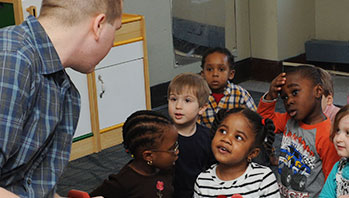- bottle
- "Colors" chart (from Week 1)
- food coloring (blue, red, yellow)
- jars of paint (red, yellow)
- water
- color
- darker
- darkest
- lighter
- lightest
- mix
- paint
- shade
MA Standards:
Speaking and Listening/SL.PK.MA.1: Participate in collaborative conversations with diverse partners during daily routines and play.
Language/L.PK.MA.1: Demonstrate use of oral language in informal everyday activities.
Language/L.PK.MA.6: Use words and phrases acquired through conversations, listening to books read aloud, activities, and play.
Head Start Outcomes:
Language Development/Receptive Language: Attends to language during conversations, songs, stories, or other learning experiences.
Language Development/Expressive Language: Uses language to express ideas and needs.
Language Development/Expressive Language: Uses increasingly complex and varied vocabulary.
PreK Learning Guidelines:
English Language Arts/Language 2: Participate actively in discussions, listen to the ideas of others, and ask and answer relevant questions.
English Language Arts/Language 3: Communicate personal experiences or interests.
Talk Together: More About Mixing Colors

© Commonwealth of Massachusetts, Department of Early Education and Care (Jennifer Waddell photographer). All rights reserved.
STEM Key Concepts: There are many different colors; Two or more colors can be combined to make a new color
ELA Focus Skills: Color Recognition, Listening and Speaking, Vocabulary
Educator Prep: Prepare bottles of blue, red, and yellow water colored with food coloring before the activity begins.
Review what children have learned about mixing colors. Have children recall and discuss what they observed when they mixed colored water and clear water in the ice cube tray. Encourage them to use color vocabulary such as, lighter shade, darker shade, darkest and lightest in their discussion. Ask,
- How is that the same or different from when we mix blue paint and white paint?
- What happens when we mix red and yellow paint?
- What do you think will happen if we mix red and yellow colored water?
Give children plenty of time to talk about their ideas. Encourage them to think about how the materials are different and how that might impact the color mixing. Record children’s ideas on the “Colors” chart under the “Mixing Colors” subhead.
Tell children they will get a chance to explore mixing colored water.
